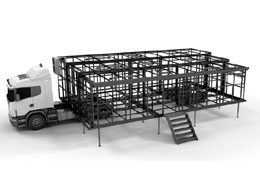STUDENTS PROJECTS
PROJECTS2012

23 January, 2013
Mobile Medical Unit
It is designed for citizens in need of access to hospital facilities, and basic design guideline was ergonomics, complete functionality and decent patient treatment.
Students: Dagklis Dimitris, Tsichritzis Leonidas
Sypervisor: Triantafullidis Georgios
University of Thessaly, Department of Architecture
Presentation Date: 5 July 2012
A modern medical unit, that aims to please every day medical needs. Autonomy, ease of access and use are its basic characteristics. It is designed for citizens in need of access to hospital facilities, and basic design guideline was ergonomics, complete functionality and decent patient treatment. A possible future approach in mobile constructions.

Medical care is one of the basic services that a state provides to its citizens. Nevertheless, not all citizens have easy access to medical facilities. Two of the main reasons are the socio-economical and the geographical obstacles. Money spent on hospital are less every year, and the morphology of Greece makes access to medical facilities difficult.

Thus, we considered that the best way to cover medical needs of citizens in need is the use of mobile medical units. The suggested unit is adjusted to a trailer truck according to European rules, with dimensions of 12/2.6/4 meters (length, width, height). The trailer can be adjusted to any truck, and can be carried to different locations.
Our main target was to maximize the trailers' usable space. It was considered that the best way to do so, was the design of three different boxes, that move telescopically, as if they were extruded. At the temporary installment location, a wall unwraps by the use of hydraulic systems, becoming the main floor of the construction, which is based on metal pillars, of variable length, in order to stand on any ground. Continuing, the two inner boxes move straight with the help of linear guides and motors, until they reach their final position. At the same time, they transfer the inner walls and equipment in a way to modify the interior spaces. This way, the usable space becomes almost tripled, from 31.2 m² to almost 80 m² and shelters the following doctors: Microbiologist, Dentist, Oculist, Gynecologist, Pathologist and Pediatrician.

The initial trailer space, shelters functions that cannot be moved. Spaces that need water (Dentist, Microbiologist, WC). The hydraulic systems are placed under the main structure of the trailer. All other spaces are occupied by other doctors, connected by the use of a central corridor - waiting room, thus giving all of them access to sun light.

We catalogued all the necessary medical equipment needed for the tasks they usually have to do, and their usage over a working day, in order to calculate the energy consumption. The air conditioning is performed by vents. During the units' use, the channels are connected between the boxes, and when the unit is on the move the channels seize to be operational and connected. Power supply is achieved by the use of wires on rails, being able to move in away similar to that of a curtain on rail.

The construction used on the unit, where chosen to fulfill two main objectives. The construction is a mobile unit that on the same time shelters medical facilities. On the exterior, white aluminum plates of 1.2 meters length and thickness of 1cm are used, while the inner floors are made of vinyl, an easily cleaned material, often used in such spaces. The roofs are coated with plasterboards, where the lighting and ventilation pipes are embodied. Inner walls are made of composite smooth material based on wood, and the colors used are white, orange, and grey. The structure of the construction is made by metal hollow bars, insulated with polystyrene.


The energy required for the proper function of the unit can be provided by connection the main electricity network. Nevertheless, the unit is capable of completely producing the energy needed for most of the year. In order to achieve this, solar panels were put to the three roofs of the unit. Their batteries, which can provide energy sufficiency for 5 days without sun, are put underneath the main construction, along with water reservoirs, needed for clean water and liquid waste disposal.













